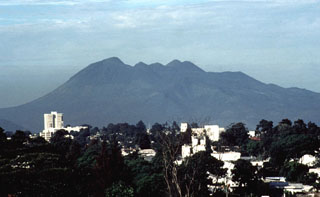Report on Pacaya (Guatemala) — January 1983
Scientific Event Alert Network Bulletin, vol. 8, no. 1 (January 1983)
Managing Editor: Lindsay McClelland.
Pacaya (Guatemala) Minor flank lava emission
Please cite this report as:
Global Volcanism Program, 1983. Report on Pacaya (Guatemala) (McClelland, L., ed.). Scientific Event Alert Network Bulletin, 8:1. Smithsonian Institution. https://doi.org/10.5479/si.GVP.SEAN198301-342110
Pacaya
Guatemala
14.382°N, 90.601°W; summit elev. 2569 m
All times are local (unless otherwise noted)
Maurice Krafft climbed Pacaya 28-29 January and observed lava emerging sluggishly from the SW flank vent that had been much more vigorously active in early 1982. The lava formed a single flow, about 3-4 m thick and less than 50 m long, that advanced only about 1 m/day. When Alfredo MacKenney had climbed the volcano 3 weeks earlier, the same vent had been feeding 3 aa flows, each about 2-3 m wide and 20 m long. None of these tiny flows were still active in late January. Moderate degassing continued from summit vents.
Geological Summary. Eruptions from Pacaya are frequently visible from Guatemala City, the nation's capital. This complex basaltic volcano was constructed just outside the southern topographic rim of the 14 x 16 km Pleistocene Amatitlán caldera. A cluster of dacitic lava domes occupies the southern caldera floor. The post-caldera Pacaya massif includes the older Pacaya Viejo and Cerro Grande stratovolcanoes and the currently active Mackenney stratovolcano. Collapse of Pacaya Viejo between 600 and 1,500 years ago produced a debris-avalanche deposit that extends 25 km onto the Pacific coastal plain and left an arcuate scarp inside which the modern Pacaya volcano (Mackenney cone) grew. The NW-flank Cerro Chino crater was last active in the 19th century. During the past several decades, activity has consisted of frequent Strombolian eruptions with intermittent lava flow extrusion that has partially filled in the caldera moat and covered the flanks of Mackenney cone, punctuated by occasional larger explosive eruptions that partially destroy the summit.
Information Contacts: M. Krafft, Cernay, France; A. MacKenney, Guatemala City.

